tow CHEVROLET TRACKER 1998 1.G Workshop Manual
[x] Cancel search | Manufacturer: CHEVROLET, Model Year: 1998, Model line: TRACKER, Model: CHEVROLET TRACKER 1998 1.GPages: 386, PDF Size: 21.17 MB
Page 235 of 386
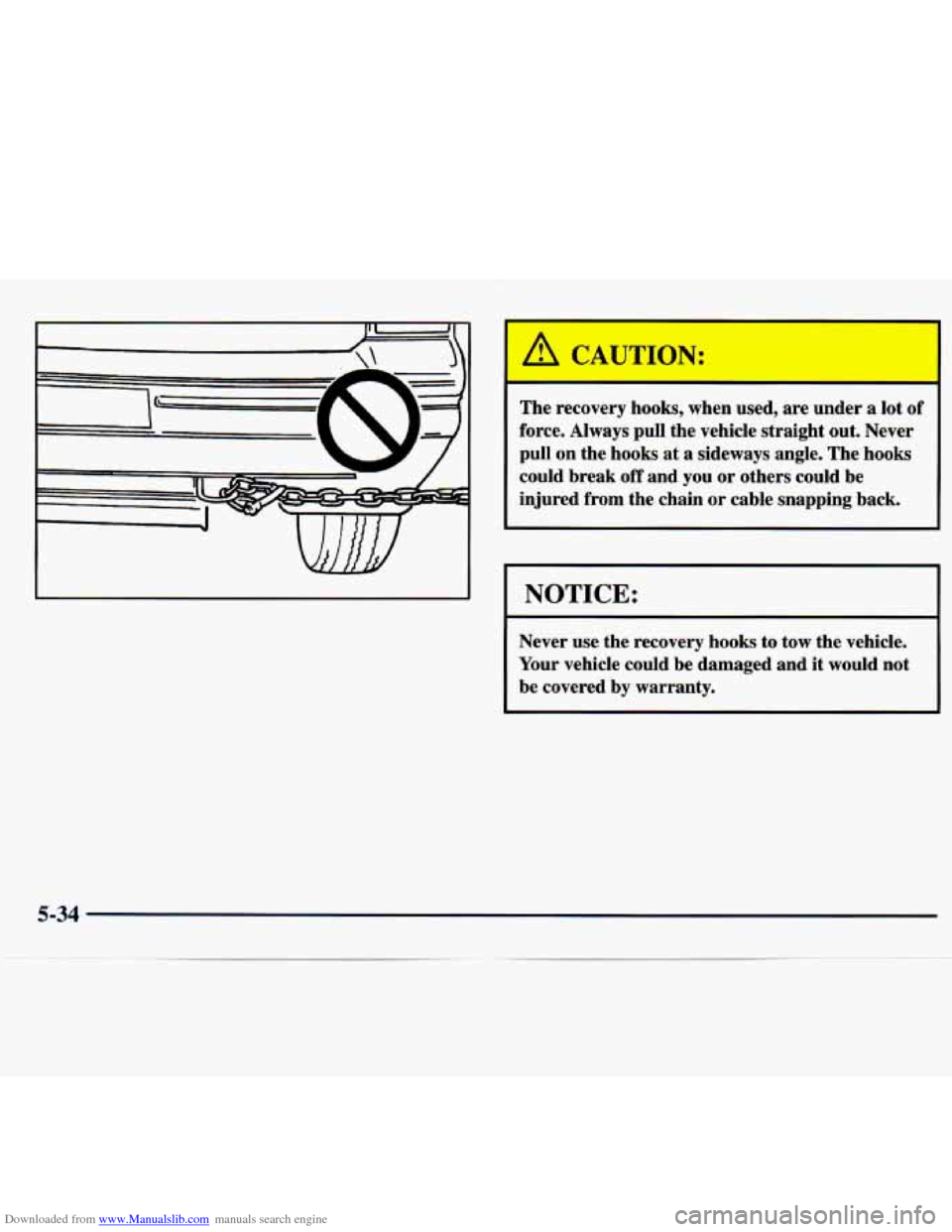
Downloaded from www.Manualslib.com manuals search engine I
I
I A CAUTION:
r
The recovery hooks, when used, are under a lot of
force. Always pull the vehicle straight out. Never
pull on the hooks
at a sideways angle. The hooks
could break
off and you or others could be
injured from the chain
or cable snapping back.
.
NOTICE:
Never use the recovery hooks to tow the vehicle.
Your vehicle could be damaged and it would not
be covered by warranty.
5-34
Page 248 of 386
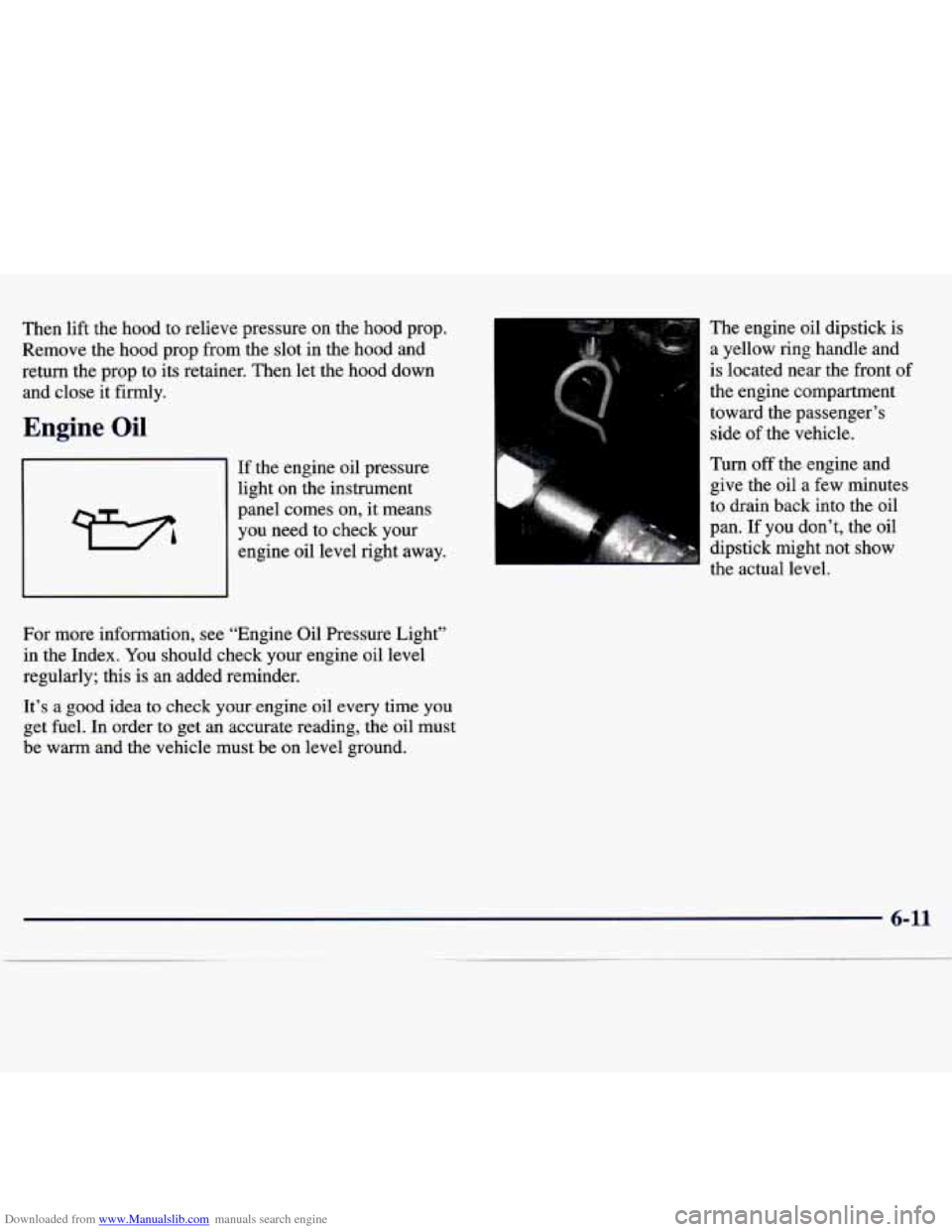
Downloaded from www.Manualslib.com manuals search engine Then lift the hood to relieve pressure on the hood prop.
Remove the hood prop from the slot in the hood and
return the prop to its retainer. Then let the hood down
and close it firmly.
Engine Oil
If the engine oil pressure
light
on the instrument
panel comes on,
it means
you need to check your
engine oil level right away.
For more information, see “Engine Oil Pressure Light”
in the Index.
You should check your engine oil level
regularly; this is an added reminder.
It’s
a good idea to check your engine oil every time you
get fuel. In order to get an accurate reading, the oil must
be warm and the vehicle must be on level ground. The engine
oil dipstick is
a yellow ring handle and
is located near the front
of
the engine compartment
toward the passenger’s side
of the vehicle.
Turn
off the engine and
give the oil a few minutes
to drain back into the oil
pan. If you don’t, the oil dipstick might not show
the actual level.
Page 249 of 386
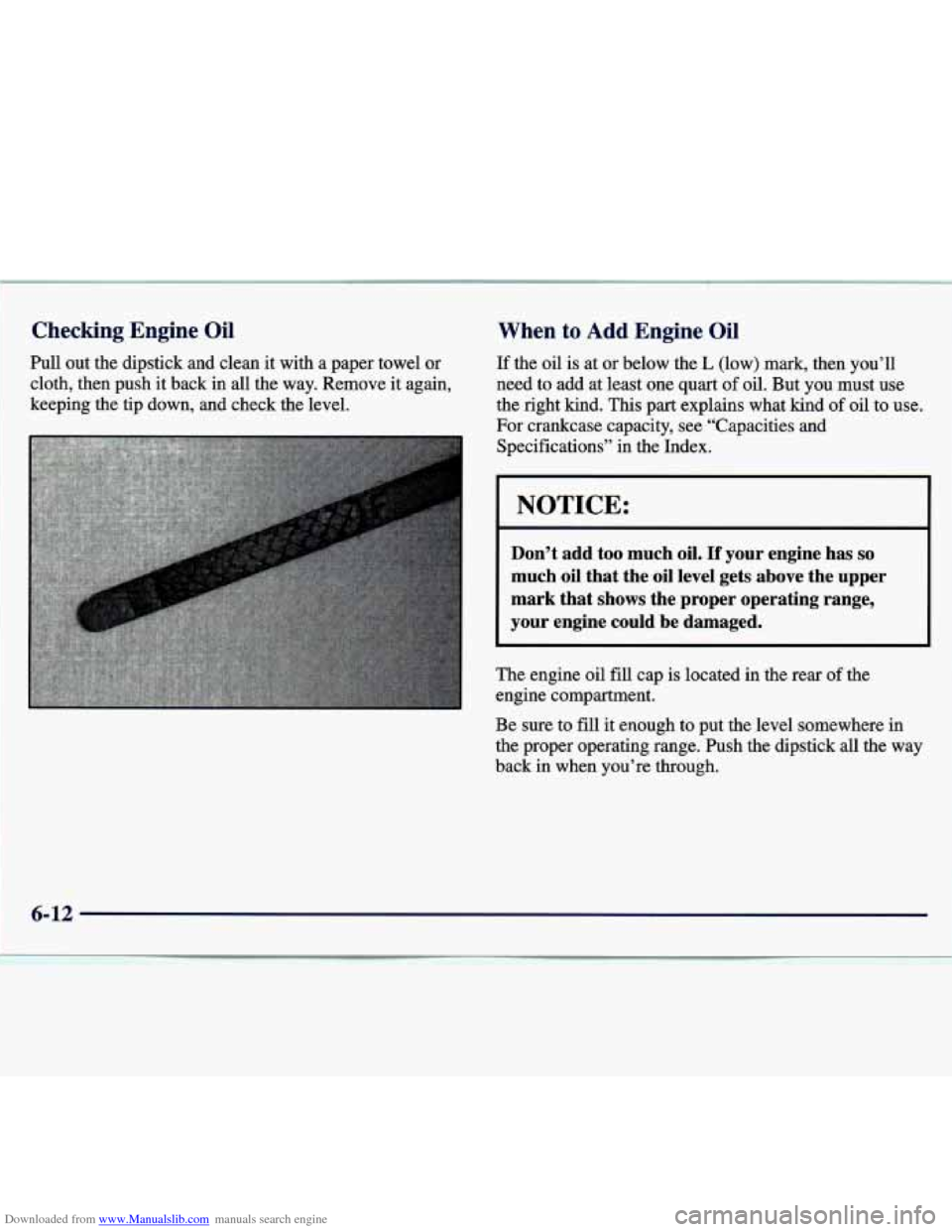
Downloaded from www.Manualslib.com manuals search engine Checking Engine Oil
Pull out the dipstick and clean it with a paper towel or
cloth, then push it back in all the way. Remove it again,
keeping the tip down, and check the level.
When to Add Engine Oil
If the oil is at or below the L (low) mark, then you’ll
need to add at least one quart
of oil. But you must use
the right kind. This part explains what kind
of oil to use.
For crankcase capacity, see “Capacities and
Specifications” in the Index.
I NOTICE: I
I Don’t add too much oil. If your engine has so I:
much oil that the oil level gets above the upper
mark that shows the proper operating range,
your engine could be damaged.
The engine oil fill cap is located in the rear of the
engine compartment.
Be sure to
fill it enough to put the level somewhere in
the proper operating range. Push the dipstick all the way
back
in when you’re through.
6-12
Page 251 of 386
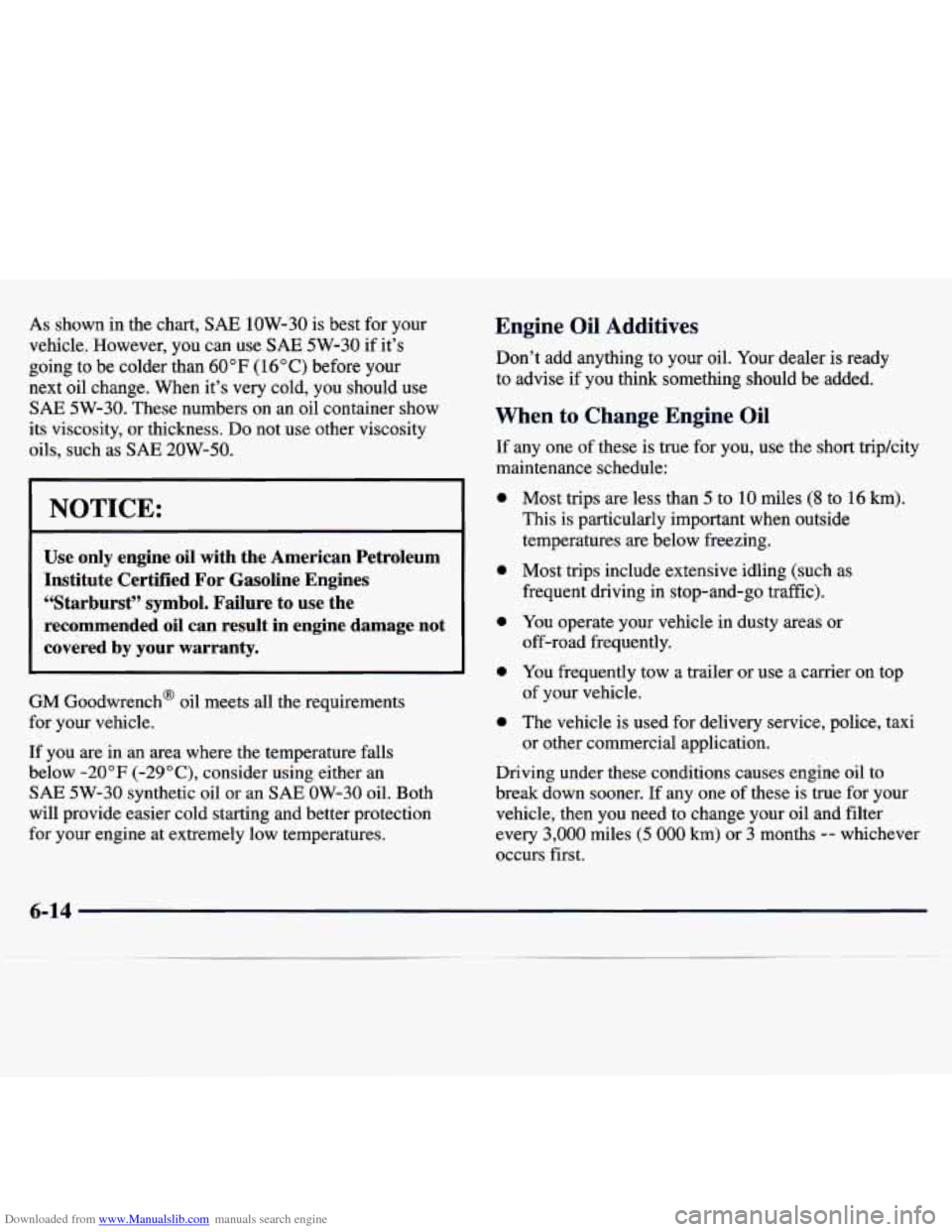
Downloaded from www.Manualslib.com manuals search engine As shown in the chart, SAE 1OW-30 is best for your
vehicle. However, you can
use SAE 5W-30 if it’s
going
to be colder than 60 “F ( 16 ” C) before your
next oil change. When it’s
very cold, you should use
SAE 5W-30. These numbers on an oil container show
its viscosity, or thickness. Do not use other viscosity
oils, such as
SAE 20W-50.
I NOTICE:
Use only engine oil with the American Petroleum
Institute Certified For Gasoline Engines
“Starburst” symbol. Failure to use the recommended oil can result in engine damage not
covered by your warranty.
GM Goodwrench@ oil meets all the requirements
for your vehicle.
If you are in an area where the temperature falls
below
-20°F (-29”C), consider using either an
SAE 5W-30 synthetic oil or an SAE OW-30 oil. Both
will provide easier cold starting and better protection for your engine at extremely low temperatures.
Engine Oil Additives
Don’t add anything to your oil. Your dealer is ready
to advise if you think something should be added.
When to Change Engine Oil
If any one of these is true for you, use the short tripkity
maintenance schedule:
0
0
0
0
0
Most trips are less than 5 to 10 miles (8 to 16 km).
This is particularly important when outside
temperatures are below freezing.
Most trips include extensive idling (such as
frequent driving in stop-and-go traffic).
You operate your vehicle in dusty areas or
off-road frequently.
You frequently tow
a trailer or use a carrier on top
of your vehicle.
The vehicle is used for delivery service, police, taxi
or other commercial application.
Driving under these conditions causes engine oil to
break down sooner. If any one of these
is true for your
vehicle, then you need to change your oil and filter
every 3,000 miles
(5 000 km) or 3 months -- whichever
occurs first.
6-14
Page 254 of 386

Downloaded from www.Manualslib.com manuals search engine Automatic Transmission Fluid
3. Pull out the filter and replace it.
4. Replace the cover and the screws.
When to Check and Change
A good time to check your automatic transmission fluid
level is when the engine oil is changed.
Change both the fluid and filter every
15,000 miles
(25 000 km) if the vehicle is mainly driven under one
or more of these conditions:
In heavy city traffic where the outside temperature
regularly reaches
90 OF (32 O C) or higher.
0 In hilly or mountainous terrain.
0 When doing frequent trailer towing.
Uses such as found in taxi, police or delivery service.
If
you do not use your vehicle under any of these
conditions, change the fluid and filter
every
100,000 miles (166 000 km).
See “Scheduled Maintenance Services” in the Index.
6-17
Page 256 of 386
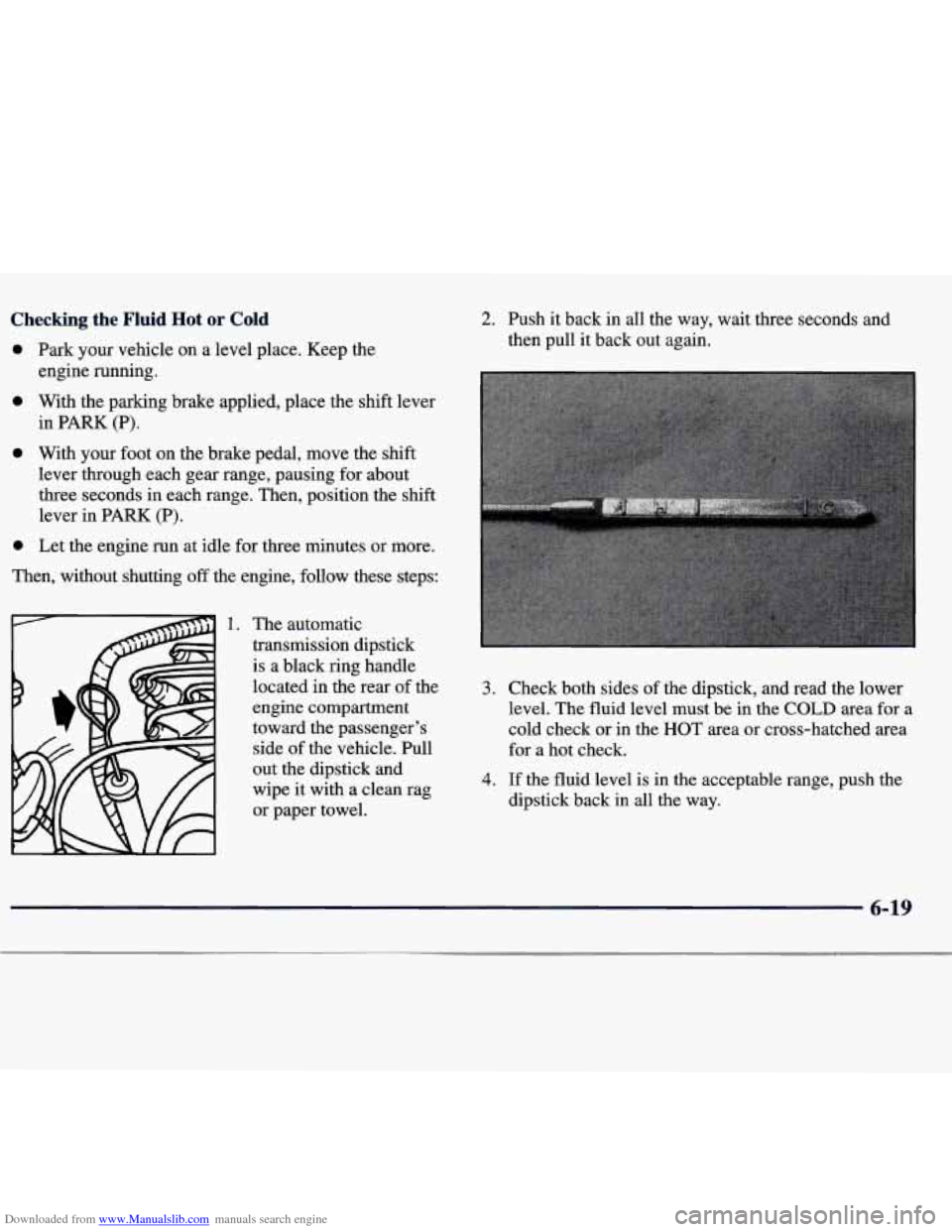
Downloaded from www.Manualslib.com manuals search engine Checking the Fluid Hot or Cold
0 Park your vehicle on a level place. Keep the
0 With the parking brake applied, place the shift lever
0 With your foot on the brake pedal, move the shift
lever through each gear range, pausing for about
three seconds in each range. Then, position the shift
lever in PARK (P).
engine running.
in PARK
(P).
0 Let the engine run at idle for three minutes or more.
Then, without shutting
off the engine, follow these steps:
1. The automatic
transmission dipstick
is a black ring handle
located in the rear of the
engine compartment
toward the passenger’s
side of the vehicle. Pull
out the dipstick and
wipe it with a clean rag
or paper towel.
!. Push it back in all the wiy,-slit three seconds and
then pull it back
out again.
3. Check both sides of the dipstick, and read the lower
level. The fluid level must be in the
COLD area for a
cold check or in the HOT area or cross-hatched area
for a hot check.
4. If the fluid level is in the acceptable range, push the
dipstick back in all the way.
6-19
Page 274 of 386
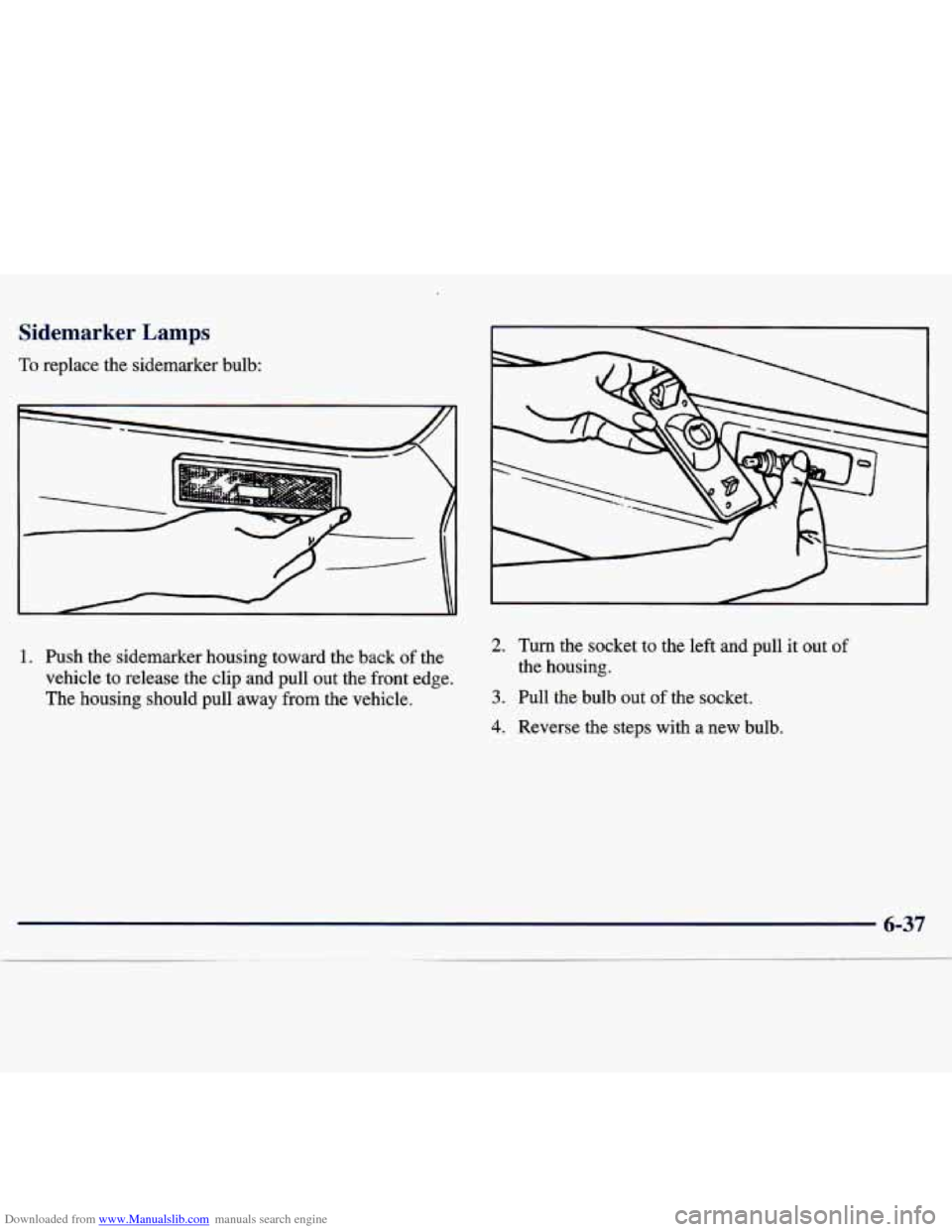
Downloaded from www.Manualslib.com manuals search engine Sidemarker Lamps
To replace the sidemarker bulb:
1. Push the sidemarker housing toward the back of the
vehicle to release the clip and pull out the front edge.
The housing should pull away from the vehicle.
2. Turn the socket to the left and pull it out of
3. Pull the bulb out
of the socket.
the
housing.
4. Reverse the steps with a new bulb.
Page 275 of 386
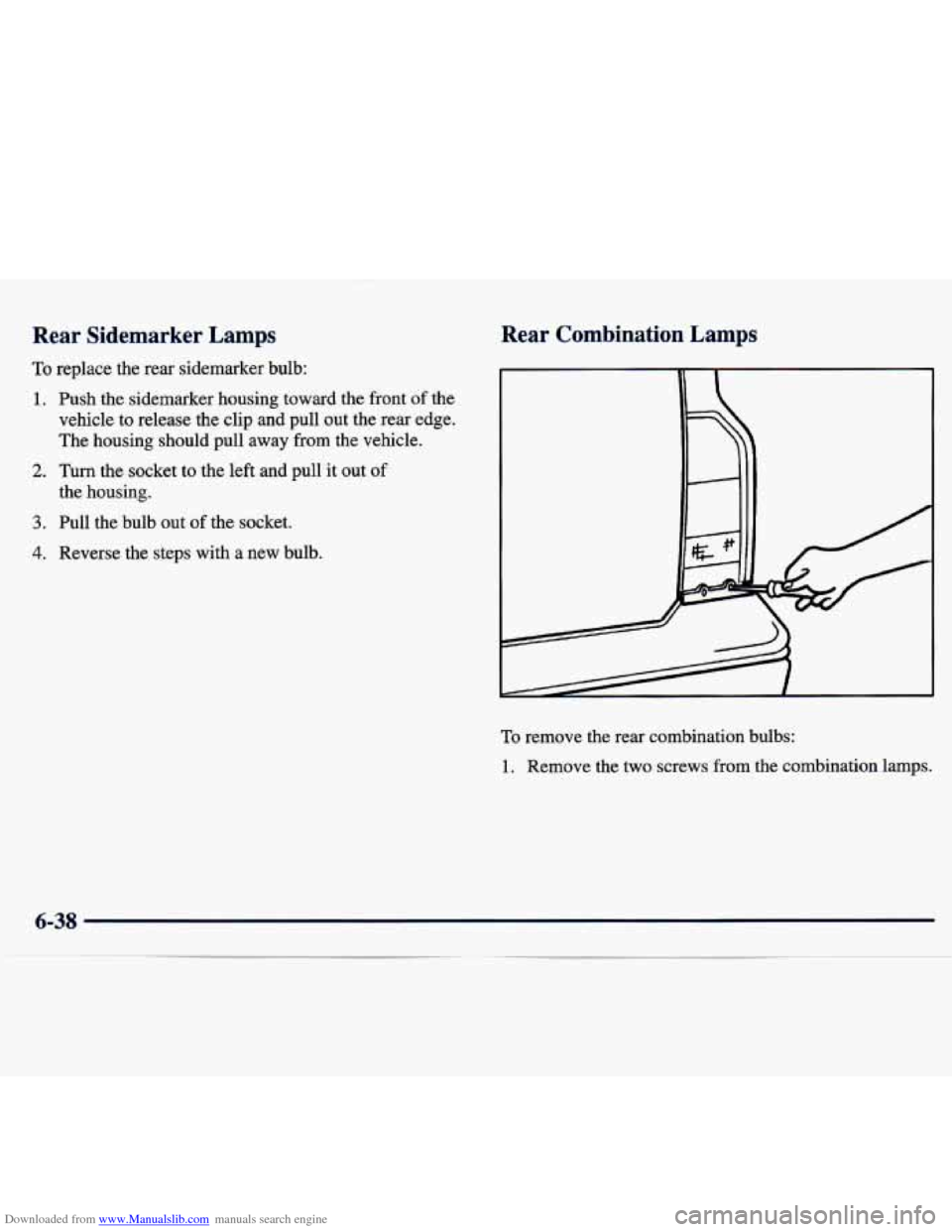
Downloaded from www.Manualslib.com manuals search engine Rear Sidemarker Lamps
To replace the rear sidemarker bulb:
1. Push the sidemarker housing toward the front of the
vehicle to release the clip
and pull out the rear edge.
The housing should pull away from the vehicle.
2. Turn the socket to the left and pull it out of
the housing.
3. Pull the bulb out of the socket.
4. Reverse the steps with a new bulb.
’ - - -- .~ Combination. Lamps
To remove the rear combination bulbs:
1. Remove the two screws from the combination lamps.
6-38
Page 280 of 386
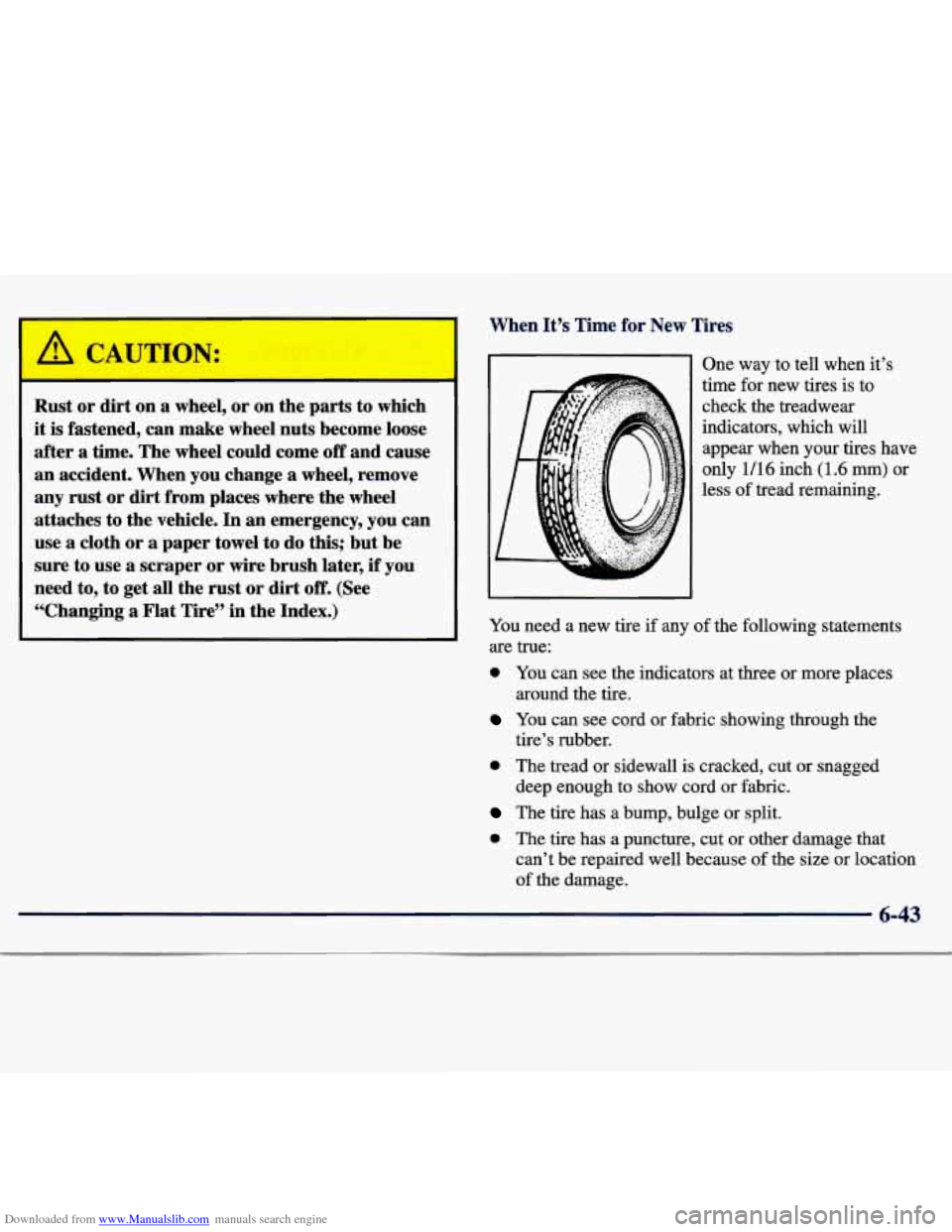
Downloaded from www.Manualslib.com manuals search engine When It’s Time for New Tires
Kust or dirt on a wheel,
or on the parts to which
it is fastened, can make wheel nuts become loose
after a time. The wheel could come off and cause
an accident. When you change a wheel, remove
any rust
or dirt from places where the wheel
attaches to the vehicle. In an emergency, you can
use a cloth or a paper towel to do this; but be
sure to use a scraper or wire brush later, if you
need to, to get
all the rust or dirt off. (See
“Changing a Flat Tire” in the Index.)
One way to tell when it’s
time for new tires is to
check the treadwear
indicators, which will appear when your tires have
only
1/16 inch (1.6 mm) or
less of tread remaining.
You need a new tire if any of the following statements
are true:
0 You can see the indicators at three or more places
around the tire.
You can see cord or fabric showing through the
tire’s rubber.
0 The tread or sidewall is cracked, cut or snagged
The tire has a bump, bulge or split.
0 The tire has a puncture, cut or other damage that
deep enough to show cord
or fabric.
can’t be repaired well because
of the size or location
of the damage.
Page 286 of 386

Downloaded from www.Manualslib.com manuals search engine Cleaning the Inside of Your Vehicle
Use a vacuum cleaner often to get rid of dust and loose
dirt. Wipe vinyl, leather, plastic and painted surfaces
with a clean, damp cloth.
Your dealer has two cleaners, Multi-Purpose Interior
Cleaner and Capture Non-Solvent
Dry Spot and Soil
Remover. They will clean normal spots and stains
very
well. You can get GM-approved cleaning products from
your dealer. (See "Appearance Care and Materials" in
the Index.)
Here are some cleaning tips:
0 Always read the instructions on the cleaner label.
0 Clean up stains as soon as you can -- before they set.
0 Carefully scrape off any excess stain.
Use a clean cloth or sponge, and change to a
clean area often.
A soft brush may be used if
stains are stubborn.
0 If a ring forms after spot cleaning, clean the entire
area immediately or it will set.
Using Multi-Purpose Interior Cleaner
on Fabric
1. Vacuum and brush the area to remove any loose dirt.
2. Always clean a whole trim panel or section. Mask
surrounding trim along stitch or welt lines.
3. Mix powdered cleaner following the directions on
the container label to
form thick suds.
4. Use suds only and apply with a clean sponge. Don't
5. As soon as you've cleaned the section, use a sponge
saturate the material and
don't rub
it roughly.
to remove the suds.
6. Wipe cleaned area with a clean, damp towel or cloth.
7. Wipe with a clean cloth and let dry.